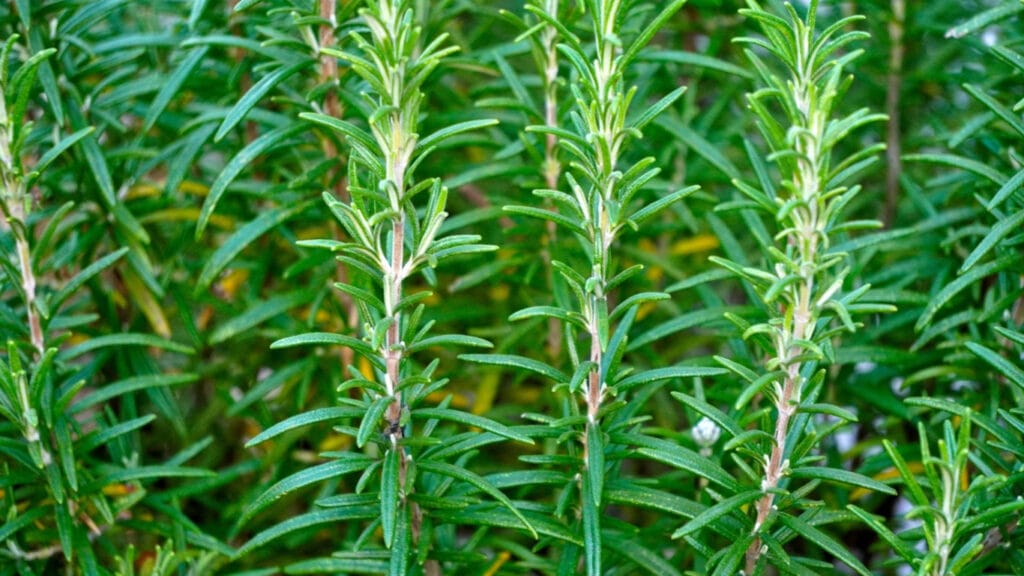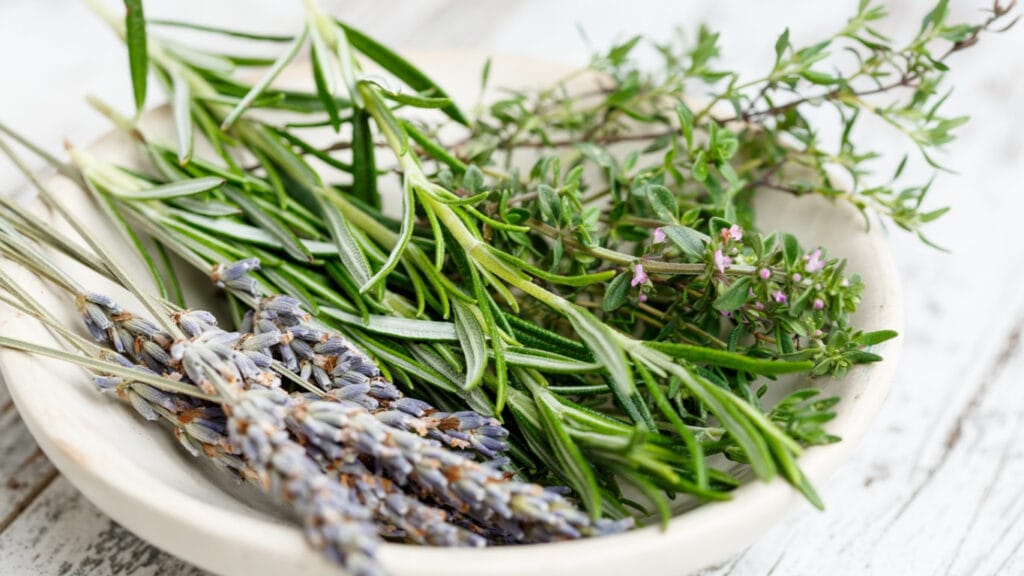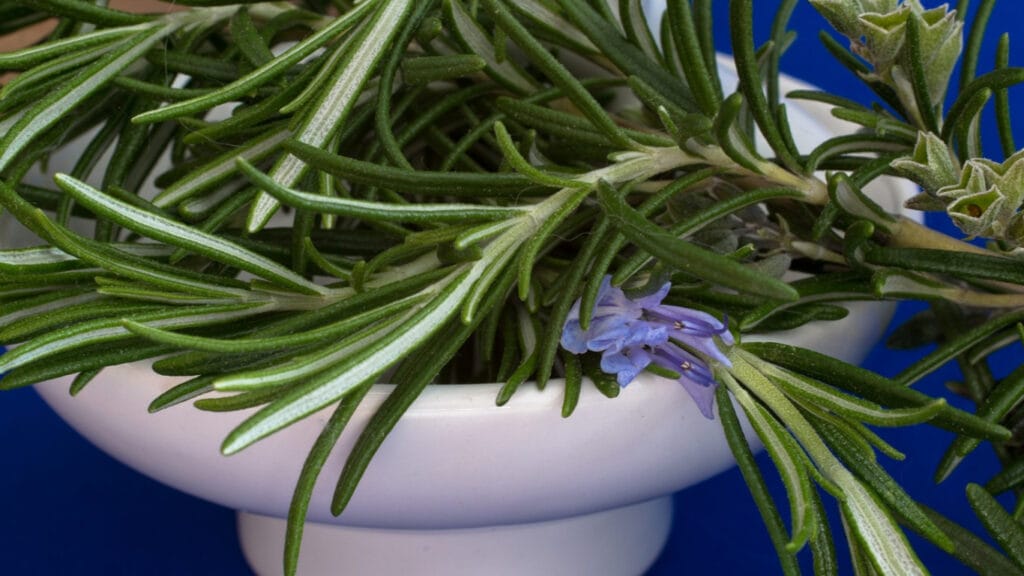Best Fertilizer For Rosemary Plants: 5 Top Picks
Rosemary, also known as rosmarinus officinalis, with its delightful aroma and vibrant foliage, is a versatile herb that adds flavor and beauty to any garden or culinary creation. To ensure its robust growth and abundant harvest, proper fertilization is key.
In this article, we will discuss rosemary fertilization, exploring the importance of selecting the right fertilizer, understanding its nutrient requirements, and various application techniques. This guide will equip you with the knowledge to nourish your rosemary plants and enjoy their rewards.
For those who want to get right to the answer of which fertilizers to use for rosemary, here they are!
Best Fertilizer For Rosemary Plants: 5 Top Picks
The best fertilizer for rosemary plants typically contains a balanced ratio of essential nutrients, with an emphasis on nitrogen and phosphorus. Here are a few recommended fertilizers considered suitable for rosemary:
- Fish Emulsion Fertilizer: Fish emulsion fertilizer is an excellent choice for rosemary. It is rich in nitrogen, which promotes healthy foliage growth. It also contains phosphorus and potassium, necessary for overall plant health and flower production. A great fish emulsion by Neptune’s Harvest.
- Liquid Kelp Fertilizer: Liquid kelp fertilizer, derived from seaweed, is beneficial for rosemary plants. It provides a wide range of essential nutrients, including nitrogen, potassium, and trace minerals. Liquid kelp fertilizer enhances plant growth, strengthens roots, and improves resistance to stress. An awesome deal by Marine Magic!
- Slow-Release Granular Fertilizer: Slow-release granular fertilizers provide a steady and prolonged release of nutrients, ensuring consistent nourishment for your rosemary plants. Look for a balanced formula with an NPK (nitrogen, phosphorus, and potassium) ratio of around 10-10-10 or 14-14-14. In granular form, I like this one by Osmocote.
- Compost: Compost is an organic and nutrient-rich fertilizer that improves soil structure and provides a slow-release source of nutrients. Incorporating compost into the soil around your rosemary plants enriches the growing environment and promotes healthy growth. Check out this highly recommended one by Fishnure.
- Worm Castings: Worm castings, also known as vermicompost, are highly beneficial for rosemary plants. They are rich in nutrients and contain beneficial microorganisms that enhance soil health and stimulate plant growth. Wiggle Worm 100% Pure Organic Worm Castings.
Remember, when applying fertilizer to rosemary plants, it is crucial not to overfeed them. Follow the manufacturer’s instructions regarding application rates and frequency. Additionally, consider the specific needs of your rosemary plants and adjust the fertilizer regimen accordingly, taking into account factors like soil quality, sunlight exposure, and overall plant health.
For more in depth and detailed information regarding fertilizing your plants and trees keep reading below!

The Importance of Fertilizing Rosemary Plants
Fertilizing rosemary plants is crucial for their overall health and productivity. By providing the necessary nutrients, you create an environment where rosemary can thrive in your garden soil or in a pot.
A well-fertilized rosemary plant exhibits vigorous growth, increased resistance to pests and diseases, enhanced essential oil production, and a higher yield of flavorful leaves. Neglecting fertilization can result in stunted growth, reduced aromatic qualities, and increased vulnerability to nutrient deficiencies.
Therefore, understanding the significance of fertilizer selection and application techniques is paramount to achieve optimal results to grow rosemary.
Table of Contents
Benefits of Using the Right Fertilizer for Rosemary
Using the right fertilizer for rosemary confers numerous advantages. Firstly, it ensures a balanced nutrient supply, meeting the plant’s specific needs and promoting robust growth.
Secondly, rosemary fertilizer enhances the plant’s ability to photosynthesize, leading to increased energy production and foliage development. Additionally, a well-fertilized rosemary plant exhibits improved root development, enabling efficient nutrient uptake from the soil.
Lastly, the right fertilizer contributes to the overall aesthetic appeal of rosemary, resulting in lush, vibrant foliage and an aromatic delight for the senses. Rosemary is a perennial that can last for 10 years or more, and depending on how you fertilize your rosemary plant it can provide many years of productivity.
Understanding The Nutrient Requirements Of Rosemary
Before delving into the specific fertilizers suitable for rosemary, it is essential to comprehend the nutrient requirements of this herb. Like all plants, rosemary requires a combination of macronutrients and micronutrients for optimal growth and development.
Macronutrients, such as nitrogen (N), phosphorus (P), and potassium (K), are required in larger quantities, while micronutrients, including iron (Fe), magnesium (Mg), zinc (Zn), and others, are needed in smaller amounts. Furthermore, understanding the ideal pH level for rosemary plants is crucial, as it affects nutrient availability and absorption.

Essential Nutrients for Rosemary Growth and Development
Rosemary relies on a diverse array of nutrients for its growth and development. Nitrogen, a crucial macronutrient, promotes leaf and stem growth, giving rosemary its lush appearance.
Phosphorus, another vital macronutrient, aids in root development, flowering, and fruiting. Potassium, the third major macronutrient, enhances overall plant health, strengthening cell structure and aiding in disease resistance.
Micronutrients Required by Rosemary
In addition to macronutrients, rosemary also requires various micronutrients to maintain optimal health. Iron is essential for chlorophyll production and overall leaf vitality. Magnesium plays a vital role in photosynthesis and enzyme activation.
Zinc is involved in hormone regulation and protein synthesis. These micronutrients, along with others such as manganese, copper, and boron, work synergistically to ensure the proper functioning of various metabolic processes within the plant.

Understanding the Ideal pH Level for Rosemary Plants
Maintaining the correct pH level is crucial for nutrient availability and uptake in rosemary plants. Rosemary thrives in slightly acidic to neutral soil, with a pH range of 6.0 to 7.0.
In this pH range, the essential nutrients are readily accessible to the plant’s roots. Testing the soil pH regularly and making necessary adjustments using organic amendments, such as compost or peat moss, ensures that the nutrients are within reach, promoting healthy growth and development.
Organic Fertilizers for Rosemary
Benefits of Using Organic Fertilizers for Rosemary
Organic fertilizers offer numerous benefits when it comes to nourishing rosemary plants. Firstly, they provide a slow and steady release of nutrients, ensuring a constant supply without the risk of nutrient burn or overfertilization.
Secondly, organic fertilizers improve soil structure and fertility over time, enhancing water retention and promoting microbial activity. Furthermore, organic fertilizers are environmentally friendly, as they are derived from natural sources and do not introduce harmful chemicals into the ecosystem.

Types of Organic Fertilizers Suitable for Rosemary Plants
Several organic fertilizers are well-suited for promoting the healthy growth of rosemary plants.
Compost, rich in organic matter, enhances soil structure, improves nutrient content, and encourages beneficial microbial activity.
Manure, whether from cows, horses, or poultry, provides a balanced mix of macronutrients and micronutrients, nurturing rosemary’s nutritional needs. Fish emulsion, derived from fish waste, is a potent organic fertilizer high in nitrogen and micronutrients, stimulating vigorous growth.
Bone meal, a slow-release fertilizer made from ground animal bones, supplies phosphorus and calcium, facilitating root development and flowering.
How to Apply Organic Fertilizers to Rosemary Effectively
Applying organic fertilizers effectively maximizes their benefits for rosemary plants. Begin by preparing the soil, ensuring it is moist but not waterlogged.
Sprinkle the organic fertilizer around the base of the plant, avoiding direct contact with the leaves to prevent foliar burn. Gently work the fertilizer into the soil using a garden fork or rake, then water the area thoroughly to facilitate nutrient absorption.
To maintain a consistent nutrient supply, repeat the application every four to six weeks during the growing season.

Synthetic Fertilizers for Rosemary
Advantages and Disadvantages of Using Synthetic Fertilizers for Rosemary
Synthetic fertilizers offer certain advantages and disadvantages when it comes to fertilizing rosemary plants. One advantage is their immediate availability to the plant, providing rapid nutrient uptake and visible results.
Synthetic fertilizers are also highly customizable, allowing for precise nutrient formulations tailored to the specific needs of rosemary. However, excessive or improper use of synthetic fertilizers can lead to nutrient imbalances, soil acidification, and environmental pollution.
Careful application and adherence to recommended dosage are crucial to avoid these potential drawbacks.
Different Types of Synthetic Fertilizers Available
Various types of synthetic fertilizers are available in the market, each offering distinct advantages for rosemary plants. Slow-release granular fertilizers, formulated with coated pellets, provide a steady nutrient supply over an extended period, minimizing the risk of overfertilization.
Water-soluble fertilizers, typically in powder or liquid form, dissolve quickly in water and are rapidly absorbed by the plant roots, delivering an instant nutrient boost. Controlled-release fertilizers, designed to release nutrients gradually over time, offer a balanced approach, combining the benefits of slow-release and fast-release fertilizers.
Application Techniques for Synthetic Fertilizers on Rosemary
When applying synthetic fertilizers to rosemary plants, precision and care are essential to avoid adverse effects. Begin by measuring the appropriate amount of fertilizer according to the instructions on the product label.
Distribute the fertilizer evenly around the base of the plant, keeping it at least six inches away from the stem to prevent root burn. Afterward, lightly incorporate the fertilizer into the topsoil using a hand tool or rake. Water the area thoroughly to facilitate nutrient uptake and minimize potential leaching.

Choosing the Right Fertilizer for Rosemary
Factors to consider when selecting a fertilizer for rosemary include nutrient composition, formulation (organic or synthetic), slow-release versus fast-release properties, soil pH compatibility, and understanding fertilizer labels and NPK ratios.
Nutrient composition is a crucial factor to consider when choosing a fertilizer for rosemary. Look for a balanced fertilizer that provides adequate amounts of nitrogen, phosphorus, and potassium, along with essential micronutrients. The nutrient ratios should be appropriate for rosemary’s specific needs, ensuring optimal growth and development.
Formulation is another important consideration. Organic fertilizers, as mentioned earlier, offer long-term benefits to the soil and plants. They improve soil fertility, enhance microbial activity, and contribute to sustainable gardening practices. On the other hand, synthetic fertilizers provide immediate nutrient availability and precise control over nutrient ratios.
Slow-release fertilizers are ideal for rosemary because they release nutrients gradually over an extended period. This helps prevent overfertilization and ensures a consistent supply of nutrients for the plant’s needs. Fast-release fertilizers, while providing quick results, should be used with caution to avoid nutrient imbalances or potential damage to the plant.
Soil pH compatibility is vital to ensure nutrient availability. Rosemary thrives in slightly acidic to neutral soil, as mentioned earlier. Therefore, choose a fertilizer that aligns with the desired pH range for rosemary plants, enhancing nutrient uptake and preventing deficiencies.
Understanding fertilizer labels and NPK ratios is essential for informed decision-making. Fertilizer labels provide valuable information about the nutrient content, application rates, and specific instructions. Pay attention to the NPK ratio, which represents the percentage of nitrogen (N), phosphorus (P), and potassium (K) in the fertilizer. For example, a fertilizer labeled as 10-10-10 contains 10% of each nutrient. Understanding the significance of these ratios helps in selecting the most suitable fertilizer for rosemary’s specific requirements.

Fertilizing Rosemary: Timing and Frequency
Optimal timing for fertilizing rosemary depends on the growth cycle and climate. Generally, it is best to apply fertilizer in early spring, just before new growth begins. This allows the plant to utilize the nutrients during the active growing season. However, if you live in a region with mild winters, you can also fertilize in late fall to provide a boost before winter dormancy.
Regarding frequency, a general rule of thumb is to fertilize rosemary every four to six weeks during the growing season. However, it’s important to monitor the plant’s response and adjust the frequency accordingly. If you notice signs of overfertilization, such as excessive foliage growth without flowering, reduce the frequency. Conversely, if the plant appears pale, lacks vigor, or shows signs of nutrient deficiencies, increase the frequency but with caution to avoid overfertilization.
Adjusting Fertilization Based on the Growth Stage of Rosemary
Rosemary goes through various growth stages, each with specific nutrient requirements. During the initial establishment phase, focus on providing a balanced fertilizer that promotes root development. As the plant matures, it requires a slightly lower nitrogen content to encourage flowering and oil production. Adjust the fertilizer application accordingly, reducing nitrogen levels while maintaining adequate phosphorus and potassium to support overall health and productivity.

Fertilizing Rosemary in Containers
Fertilizing potted rosemary requires special considerations due to the limited nutrient availability in containers. Container size plays a crucial role in nutrient availability, as smaller pots restrict root growth and nutrient uptake. It’s advisable to choose a container that provides ample space for the plant’s root system to expand, ensuring sufficient access to nutrients in the potting mix.
Choosing the right potting mix is equally important. Opt for a well-draining mix that retains moisture without becoming waterlogged. Additionally, select a potting mix that contains organic matter, such as compost or aged bark, to provide a slow-release source of nutrients over time.
When applying fertilizer to potted rosemary, follow the same principles as for garden-grown plants. However, be mindful of the smaller space and adjust the application rates accordingly. It’s crucial to avoid overfertilization in containers, as it can lead to nutrient imbalances, root burn, or even plant death.
Fertilizer Application Techniques for Rosemary
There are several fertilizer application techniques to consider when fertilizing rosemary plants. Each technique offers its unique advantages and ensures efficient nutrient delivery.
- Topdressing with fertilizer: Sprinkle the fertilizer evenly on the soil surface around the base of the plant. This technique is suitable for both garden-grown and potted rosemary. Afterward, lightly incorporate the fertilizer into the top layer of soil, taking care not to disturb the plant’s roots.
- Foliar feeding: This technique involves applying a diluted fertilizer solution directly to the leaves of the rosemary plant. It is useful for providing a quick nutrient boost or addressing specific nutrient deficiencies. Use a sprayer to apply the solution, ensuring thorough coverage of the foliage. However, foliar feeding should not replace regular soil fertilization but rather complement it.
- Drenching or soaking the soil: This technique is particularly beneficial for potted rosemary. Pour a diluted fertilizer solution directly onto the soil until it saturates the root zone. Allow the excess solution to drain out from the drainage holes. Drenching ensures efficient nutrient absorption by the roots and prevents nutrient leaching.
- Preparing a fertilizer tea: Fertilizer teas are created by steeping organic fertilizers in water to extract their nutrients. This method is suitable for both garden-grown and potted rosemary. After steeping, strain the liquid and use it to water the plants. Fertilizer teas provide a gentle, organic nutrient source and can be applied every few weeks during the growing season.
Signs of Nutrient Deficiencies in Rosemary
Nutrient deficiencies can manifest in rosemary through various visual symptoms and leaf discoloration. These signs serve as indicators of specific nutrient deficiencies and help diagnose the problem accurately. Some common nutrient deficiencies in rosemary include:
- Nitrogen deficiency: Yellowing of older leaves and overall stunted growth.
- Phosphorus deficiency: Purplish discoloration on the leaves, especially in younger foliage, and reduced flowering.
- Potassium deficiency: Yellowing or browning of leaf margins, accompanied by weak stems and reduced overall vigor.
- Iron deficiency: Yellowing of new leaves while the veins remain green, a condition known as chlorosis.
- Magnesium deficiency: Yellowing between leaf veins, leading to a marbled appearance.
- Micronutrient deficiencies: Various visual symptoms, including leaf deformities, mottling, or interveinal chlorosis, may indicate specific micronutrient deficiencies such as zinc, manganese, or copper.
Diagnosing and treating nutrient deficiencies in rosemary require careful observation and identification of the specific symptoms. Soil testing can also provide valuable insights into nutrient imbalances and deficiencies, enabling targeted corrective measures.
Common Mistakes to Avoid When Fertilizing Rosemary
While proper fertilization is essential, it’s equally important to avoid common mistakes that can hinder rosemary’s growth and health.
- Over-fertilization: Applying excessive amounts of fertilizer can lead to nutrient imbalances, salt accumulation in the soil, and even plant damage. Always follow the recommended dosage and frequency specified on the fertilizer label.
- Under-fertilization: Insufficient nutrient supply can result in stunted growth, weak plants, and reduced productivity. Monitor the plant’s growth and health, and adjust fertilization practices if necessary.
- Improper application techniques and their impact: Applying fertilizers incorrectly can have detrimental effects on rosemary plants. Avoid directly applying fertilizer to the leaves, as this can cause foliar burn. Additionally, ensure that the fertilizer is evenly distributed around the plant’s base and incorporated into the soil to prevent uneven nutrient absorption. Proper watering after fertilization is also crucial to facilitate nutrient uptake and prevent the risk of fertilizer burn.
Q&A-Rosemary and Fertilizer
Q: What is the best fertilizer for rosemary plants?
A: The best fertilizer for rosemary plants is one that is specifically formulated for herbs or Mediterranean plants. Look for a fertilizer that has a balanced ratio of nutrients, such as a 10-10-10 or 5-5-5 NPK (nitrogen, phosphorus, and potassium) ratio.
Q: Do rosemary plants need fertilizer?
A: Yes, rosemary plants do need fertilizer to thrive. Fertilizing your rosemary plants helps provide them with the necessary nutrients they need to grow and stay healthy.
Q: What type of fertilizer does rosemary need?
A: Rosemary plants prefer a well-balanced, slow-release organic fertilizer. You can also use liquid fertilizers specifically formulated for herbs or Mediterranean plants.
Q: How much fertilizer should I use on my rosemary plants?
A: It’s important not to over-fertilize your rosemary plants. Use a fertilizer according to the manufacturer’s instructions, usually about a teaspoon per gallon of water.
Q: What is the purpose of plant food for rosemary?
A: The purpose of plant food for rosemary is to provide essential nutrients that the plant needs for healthy growth. Fertilizers supply nutrients like nitrogen, phosphorus, and potassium, which are necessary for strong root development and overall plant health.
Q: When is the best time to fertilize rosemary plants?
A: The best time to fertilize rosemary plants is in the late summer or early fall season. This allows the plants to absorb the nutrients before going dormant during the winter.
Q: Do rosemary plants need to be fertilized regularly?
A: Rosemary plants don’t need to be fertilized as frequently as other plants. Fertilize them once or twice a year, preferably in late summer or early fall, when they are actively growing.
Q: What are the different types of rosemary fertilizer?
A: There are various types of rosemary fertilizers available, including liquid fertilizers, granular fertilizers, organic composts, and commercial fertilizers specifically formulated for herbs or Mediterranean plants.
Q: How do I apply the fertilizer to my rosemary plants?
A: To apply the fertilizer, dilute the recommended amount in water according to the instructions on the package. Then, water your rosemary plants with the fertilizer solution, making sure to cover the entire soil around the base of the plant.
Q: Can I use organic plant food for my rosemary plants?
A: Yes, you can definitely use organic plant food for your rosemary plants. Organic fertilizers, such as compost or natural plant-based fertilizers, are a great option and provide a slow-release of nutrients over time.
Conclusion
Choosing the best fertilizer for rosemary and applying it correctly are vital steps in ensuring optimal growth, flavor, and beauty of this beloved herb. By understanding rosemary’s nutrient requirements, selecting the appropriate fertilizer type and formulation, and following best practices for application, you can provide your rosemary plants with the nourishment they need to thrive. Remember to monitor the plant’s response, adjust fertilization frequency as necessary, and address any nutrient deficiencies promptly. With proper fertilization techniques and care, your rosemary plants will reward you with abundant foliage, delightful aroma, and culinary delight throughout the seasons.
You May Also Like:
Are Eggplants Perennial? 7 Secrets To Year Round Eggplants!
Can I Drink Moringa Tea At Night? 14 Reasons You Should!
How Cold Is Too Cold For Your Tomato Plants? The Cold Hard Facts!
Best Fertilizer For Fig Trees In Pots: 9 Top Picks
Health Benefits Of Moringa Oleifera: The 1-2 Punch Against Disease

